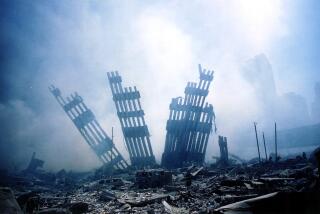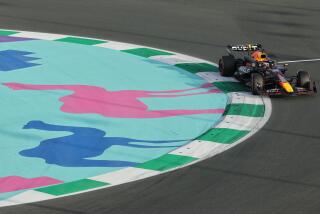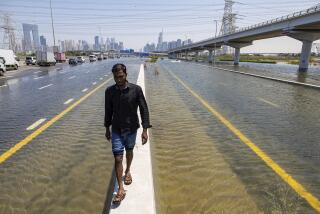Deconstructing Dubai
- Share via
Dubai
The Vulnerability of Success
Christopher Davidson
Columbia University Press: 376 pp., $32.50
--
Back in February, Related Cos., the developer working with architect Frank Gehry on a $3-billion mixed-use complex on Grand Avenue in downtown Los Angeles, announced it was bringing in a new investment partner: Istithmar, a sovereign wealth fund controlled by the ruling family of Dubai. The deal, which gave Istithmar a 45% stake in the project, was reminiscent of the 1980s, when Japanese companies took advantage of a sagging American economy to acquire skyscrapers and other high-profile buildings in Manhattan and Los Angeles. And as was the case 20 years ago, people began asking curious, anxious questions about the flush foreigners: Where did they get so much cash, and what’s leading them to use it to buy up -- or at least buy into -- our skylines?
For many Angelenos, the answer probably seemed obvious: The Istithmar fund gets its money from oil, and Dubai’s sheiks are keen to stash it abroad as a way to diversify their portfolios before the petroleum reserves back home run dry. As Christopher Davidson’s “Dubai: The Vulnerability of Success” makes clear, though, that explanation is mostly wrong. Dubai, one of seven semiautonomous Persian Gulf sheikdoms that make up the United Arab Emirates, has turned itself into a rising and nimble economic power that actually depends on everything but oil to fill its coffers and fund its wide-ranging domestic and international ambitions.
Unlike its supremely wealthy neighbor Abu Dhabi, which is practically drowning in petroleum, Dubai never had much of the stuff to begin with. Its production peaked in 1991, at around 420,000 barrels a day -- less than half a percent of what Saudi Arabia now produces -- and today no more than 5% of Dubai’s GDP comes from oil-related revenue. The rest is provided by a remarkably forward-looking economic engine that draws steady profits from trade, luxury tourism, high technology and high-profile real estate investments like the one on Bunker Hill.
While we moan about gas prices and try rather fitfully to imagine a post-petroleum urban future, Dubai has largely already arrived there. Even as construction workers hammer away at the 2,300-foot-high Burj Dubai tower, which will rank when finished later this year as the tallest building in the world, Dubai is showing its ambition below ground as well. The emirate is building a sophisticated subway system that will be mostly complete by 2010 and rival any in the developing world -- and many (ahem) in the West.
As Davidson traces Dubai’s rise from sleepy Gulf port to player on the world scene, he devotes equal time to highlighting “several key problems that lie beneath the emirate’s glittering facade.” Now a fellow at the Institute for Middle Eastern and Islamic Studies at England’s Durham University, Davidson earlier worked as an assistant professor of political science at the Sheikh Zayed University in Abu Dhabi and Dubai, and his familiarity with the quirks and customs of Dubai helps lift the text, while quite dry, above typical think-tank fare.
The book defines Dubai as a new breed of political and urban animal, equal parts Las Vegas and Singapore. Nominally Islamic but increasingly Western on its public face, Dubai combines laissez-faire economic policies with an unapologetically closed political system. As a place to run an international business, Dubai has few peers, as was demonstrated last year when defense contractor Halliburton, to Washington’s chagrin, relocated its corporate headquarters there from Houston. As a political entity, Davidson writes, “Dubai is still an autocracy, where real evidence of an opening for true democracy proves hard to find, and where far less political reform has occurred than in neighboring Gulf states, including even Saudi Arabia.”
As singular a place as Dubai has become, with its just-add-water skyline and its indoor ski resorts, with its archipelagoes of man-made islands topped by multimillion-dollar villas, its blueprint for success may also be a sign of things to come. If the titanic, expensive struggle between capitalism and communism dominated the geopolitics of the second half of the 20th century, the early years of the 21st are shaping up as a test for a handful of hugely ambitious regimes trying to mix free-market growth with autocratic rule. Like China, if on a far smaller scale, Dubai is involved in a high-stakes game of chance, betting that as long as it can keep its economy revving at a high enough level, it will be able to keep real political restructuring at bay.
Unlike China, however, Dubai’s government can take some patriotic solace in the fact that the repressed masses are guest workers rather than its own citizens. Dubai is both a land of opportunity and a harsh proving ground for its lower-class immigrant workforce, particularly the South Asian construction workers brought over to build a mushrooming collection of skyscrapers in punishing desert heat. In Dubai, economic growth is a means of maintaining a patronage system for the emirate’s 80,000 or so actual citizens, who make up just 5% of the total population of roughly 2 million. China’s boom, meanwhile, is largely being carried on the backs of its own people, many of them internal migrants desperate for work. Dubai’s so-called nationals make up what Davidson calls “a business-focused national population that to some extent views the government as a board of directors rather than as a forum for political participation.” Dubai’s first elections were held in 2006, for a handful of regional positions, and were “widely regarded as farcical.”
That patronage system may pose risks to Dubai’s future stability. Because they grow up coddled by “an extreme nanny state in which every aspect of their financial lives has been taken care of,” Davidson argues, Dubai’s citizens are hardly models of diligent ambition. “A weekday visit to any of Dubai’s major shopping malls [reveals] legions of able-bodied young men drinking coffee and playing video games.”
The emirate’s much-vaunted commitment to free trade has a dark side: It has become a busy hub for gunrunning, money laundering and human trafficking. In global political terms, Dubai leads a risky double life. It operates under the Western military umbrella but continues to be attentive to Islamic fundamentalism and is frequently accused of paying protection to extremists to prevent terror attacks on its own soil. The UAE was one of only three states to recognize the Taliban government during its reign in Afghanistan, and in the wake of the U.S. invasion of Iraq, a number of Saddam Hussein’s top lieutenants took refuge there.
Washington has long had serious worries about the ruling sheiks’ relationship with Al Qaeda. Two of the Sept. 11 attackers were UAE natives, and much of the funding for the attacks themselves was wired from or laundered in the emirates. In 1999, American forces were ready to fire cruise missiles on a hunting camp in a remote corner of Afghanistan where they believed Osama bin Laden was hiding. Before they could pull the trigger, intelligence officials noticed that a C130 transport plane with UAE markings was sitting on an airstrip at the camp. According to the Sept. 11 commission report, the strike was called off because “policymakers were concerned about the danger that [it] would kill an Emirate prince or other senior officials who might be with bin Laden or close by.”
At the same time, curiously and dangerously enough, Dubai’s close relationship to Washington makes the emirate itself a possible terror target from the same extremists it is accused by the West of harboring. Rather ominously, Davidson cites a fiery threat from a group calling itself the Al Qaeda Organization in the Emirates and Oman. The statement demands that all U.S. military installations in the UAE be dismantled. Failing that, it concludes, the UAE’s ruling families will find “the mujahideen in their faces.”
More to Read
Inside the business of entertainment
The Wide Shot brings you news, analysis and insights on everything from streaming wars to production — and what it all means for the future.
You may occasionally receive promotional content from the Los Angeles Times.











